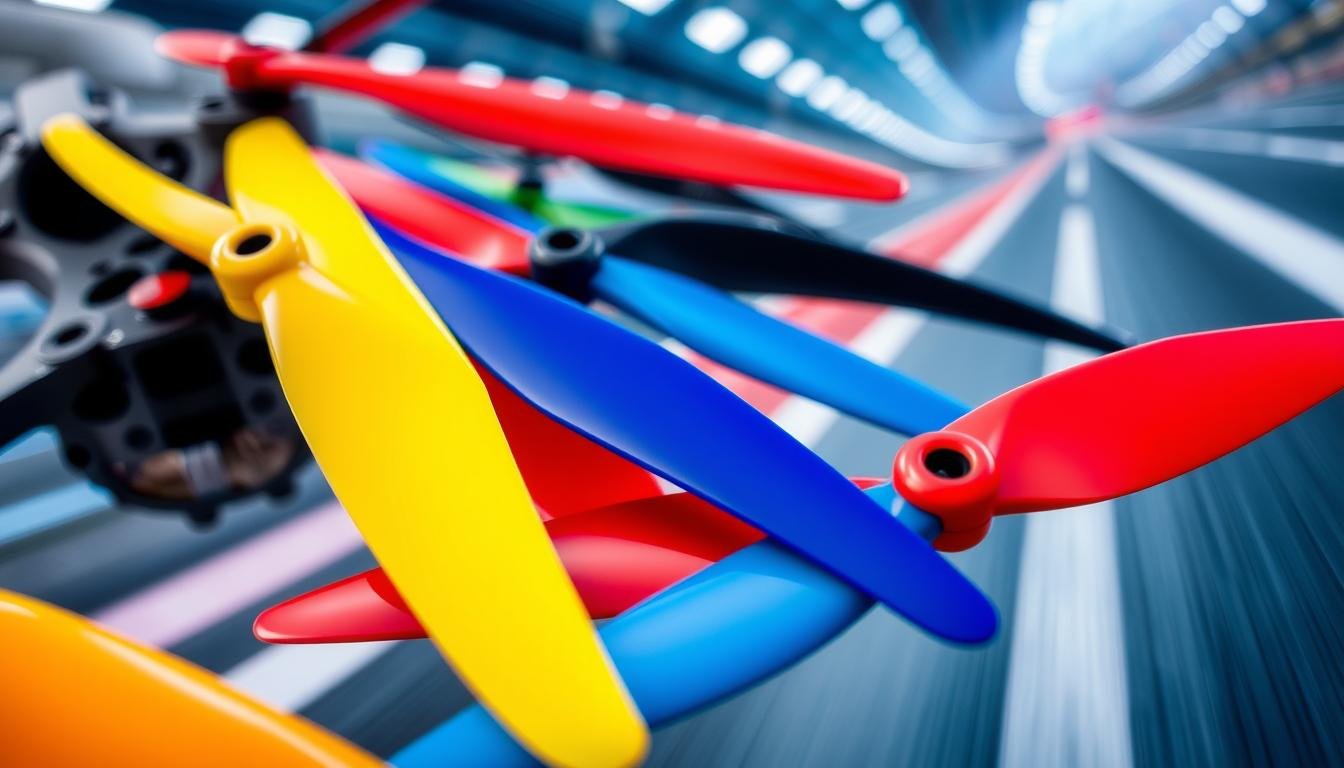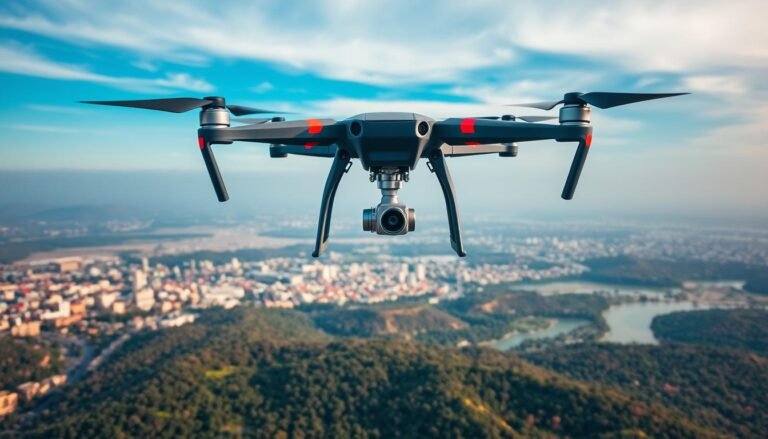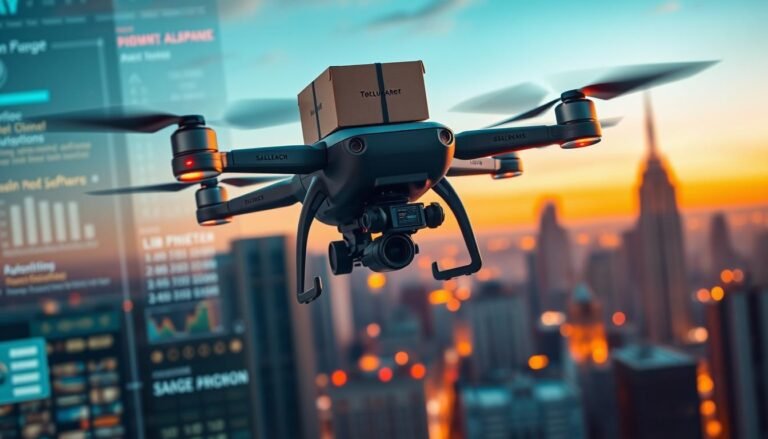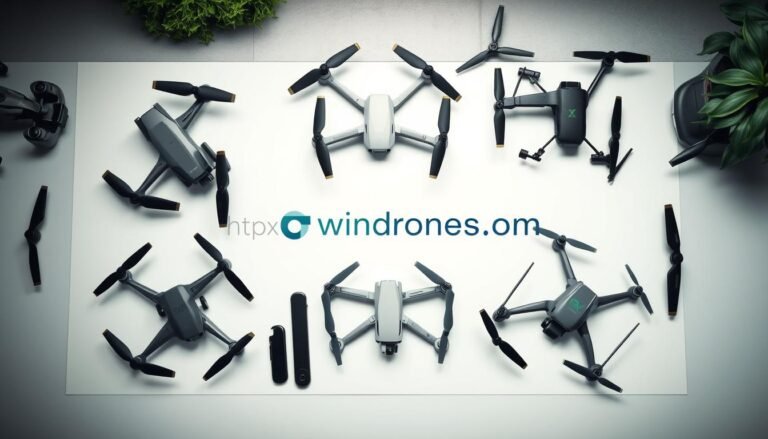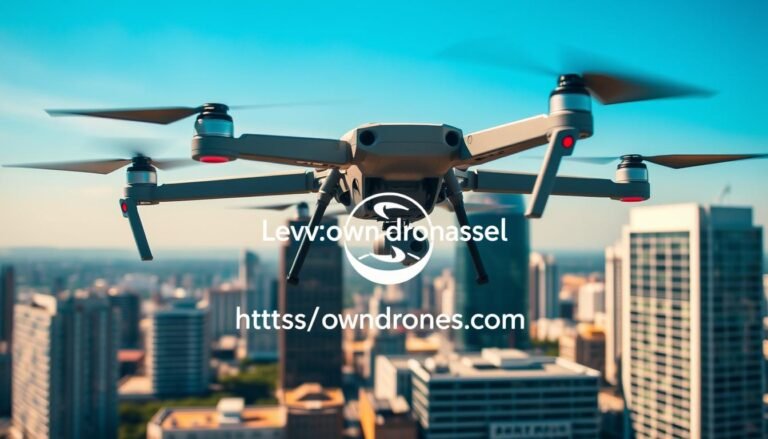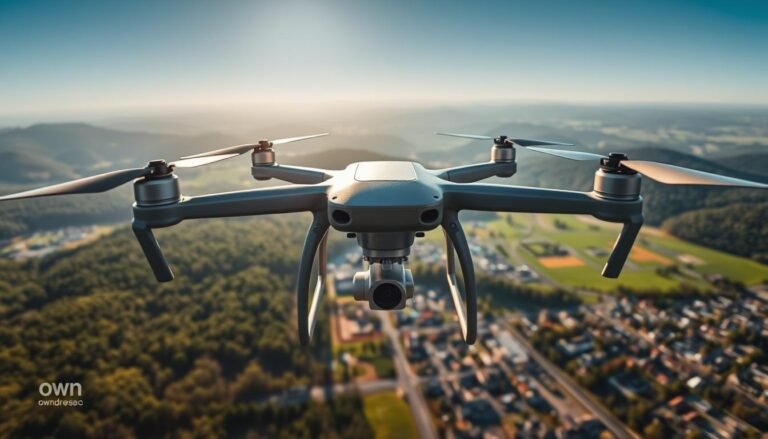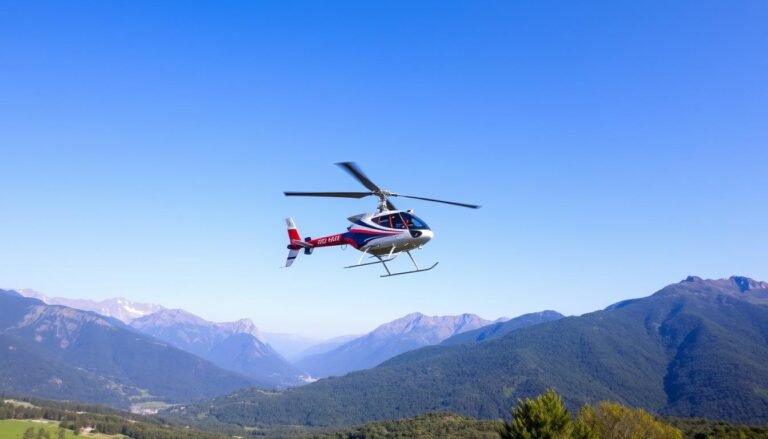Ultimate Guide to Drone Racing Propellers: FPV Performance
Want to boost your FPV drone racing game? The right propellers can transform your drone’s performance. Let’s explore the world of racing propellers. We’ll look at types, designs, and brands for peak racetrack performance.
FPV drone racing has soared in popularity. It attracts thrill-seekers worldwide. These speedy drones can hit 120 km/h, perfect for competitive racing.
Many racers build custom drones to match their flying style. Picking the right propellers is key to this process.
This guide helps both beginners and pros choose the best racing propellers. We’ll cover carbon fiber, folding, and high-performance options. You’ll learn how propellers affect speed, agility, and overall performance.
Key Takeaways
- FPV drone racing propellers come in various types, including carbon fiber, folding, and high-performance options
- Propeller pitch patterns and blade design significantly impact a racing drone’s performance and efficiency
- Lightweight propellers offer benefits such as increased speed and agility for racing drones
- Compatibility with major drone manufacturers is an important consideration when selecting racing propellers
- Proper maintenance, including cleaning, storage, and balancing, is essential for optimal propeller performance
Introduction to FPV Drone Racing Propellers
High-performance propellers are vital in FPV drone racing. They determine a drone’s speed, agility, and overall performance. These specialized props give pilots an edge on the track.
When picking propellers, think about material, blade design, and motor compatibility. The right props can boost your drone’s abilities. They help you navigate turns and reach top speeds with precision.
The USA drone market was worth $11.1 billion in 2022. This is 28.7% of the global market share. As FPV drones improve, demand for quality racing propellers grows.
Propeller names show Length x Pitch x Blades or LengthPitch x Blades. This format indicates dimensions and blade count.
| Frame Size | Typical Prop Length | Typical Prop Pitch |
|---|---|---|
| 2.5in or smaller | 1.2in – 2.5in | 1.0 – 2.5 |
| 3in – 4in | 3in – 4in | 2.5 – 4.0 |
| 5in | 5in | 3.0 – 5.5 |
| 6in+ | 6in+ | 4.0 – 7.0 |
Consider frame size and motor specs when choosing racing drone propellers. Longer props with higher pitch offer more speed but need stronger motors.
Balance propeller length, pitch, and motor power to maximize your drone’s racing potential. This balance is key to top performance on the track.
Types of Drone Racing Propellers
Propellers are crucial for racing drone performance. They come in various types, each with unique advantages. Let’s explore popular drone racing propeller options.
Carbon Fiber Propellers
Carbon fiber props are durable and strong. They’re lightweight and can handle high-speed racing. Many racers prefer them for superior performance and responsiveness.
Folding Propellers
Folding props are great for compact storage and easy transport. They fold inward when not in use. Centrifugal force extends them during flight.
These propellers are ideal for traveling to race events. They also work well for storing racing drones in compact cases.
High-Performance Propellers
High-performance props maximize speed and efficiency. They often have advanced designs for maximum thrust and minimal drag. These propellers come in various sizes and configurations.
However, they may require more power. This can impact the overall battery life of the racing drone.
Consider propeller diameter, pitch, and blade count when selecting. Racing drones often use smaller, agile propellers for speed and quick maneuvers.
Two-blade propellers are efficient and produce less drag. They’re great for top speed. Three or four-blade propellers offer better stability and control.
| Propeller Brand | Model | Size | Price |
|---|---|---|---|
| ARRIS | 5045 3-blade | 5 inches | $14.99 (10 pairs) |
| DALPROP | Cyclone Series T5046C | 5 inches | $2.99 (single) |
| T-MOTOR | T5143S Ultralight | 5 inches | $2.99 (2 pieces) |
| EMAX | Avan Long Range | 6 inches | $3.99 (2 pieces) |
Your racing drone propeller choice depends on your needs and style. Try different types to find the right balance. This will help you excel in drone racing.
Propeller Pitch Patterns for Racing Drones
Propeller pitch patterns are vital for racing drone performance. They affect speed, thrust, and efficiency. Choosing the right pattern is key for maximizing your drone’s capabilities.
Propeller pitch is measured in inches. It shows how far a propeller moves in one rotation. Higher pitch means more thrust and speed. Lower pitch offers better stability and control.
- 4×4.5: This pattern balances speed and control. It’s suitable for most racing scenarios.
- 5×4.5: It generates more speed and thrust. This pattern is ideal for long straights and open courses.
- 5×4: This lower pitch prioritizes stability and maneuverability. It’s perfect for tight, technical tracks.
The best propeller pitch pattern depends on several factors. These include motor size, battery voltage, and overall weight. Experiment with different patterns to find your ideal setup.
Monitor your drone’s performance during tests. This helps you find the sweet spot for your flying style. It also helps you adapt to various race conditions.
| Pitch Pattern | Advantages | Ideal Racing Conditions |
|---|---|---|
| 4×4.5 | Balanced speed and control | Varied track layouts |
| 5×4.5 | Higher speed and thrust | Long straights and open courses |
| 5×4 | Increased stability and maneuverability | Technical tracks with tight turns |
A well-chosen propeller pitch pattern can make all the difference in your racing drone’s performance. Take the time to experiment and find the perfect balance for your setup.
Propeller Blade Design and Performance
Propeller blade design is crucial for racing drone performance. It affects the drone’s efficiency, speed, and maneuverability. Drone racers must carefully consider blade design for optimal results.
Most drones have four to six propellers for stability and control. TriBlade Propellers offer improved lift and reduced vibration. Variable Pitch Drone Propellers allow in-flight angle adjustments for better performance.
Blade Shape and Efficiency
Propeller blade shape greatly impacts drone efficiency. Different shapes offer unique advantages for various flying needs.
- Thin electric propellers reduce drag and increase speed. They handle high rotations per minute well.
- Slow flyer propellers are designed for low-speed environments. They often feature noise-reducing designs.
- Carbon fiber propellers are lightweight and durable. They enhance overall performance of racing drone accessories.
Blade Count and Thrust
The number of blades affects the drone’s thrust. RC propellers come in two-bladed and multiple-bladed versions. Each type has its own benefits.
| Blade Count | Advantages |
|---|---|
| Two-Bladed | Higher efficiency, less drag, suitable for high-speed racing |
| Multi-Bladed | Increased thrust, improved stability, better for carrying payloads |
Choosing the right blade count depends on the drone’s needs. Design software like Heliciel offers various propeller setups.
These options include ducted propellers and counter-rotating blades. Modified axial distances between propellers can also be adjusted for optimal performance.
Lightweight Drone Propellers for Racing
Drone racing demands lightweight propellers for peak performance. These high-performance props give racers an edge on the track. They offer advantages that help pilots push their drones to the limit.
Lightweight drone propellers boost speed and agility. They reduce overall drone weight, enabling quicker acceleration and responsive handling. This is crucial for tight, technical courses requiring precise maneuvers.
Benefits of Lightweight Props
These propellers also extend flight times. Less weight means motors and batteries work more efficiently. This advantage helps in endurance competitions and long practice sessions.
A real-world example shows their impact. A lightweight quad with a 2s 5000mah battery hovered for 52 minutes indoors. Outdoors, with added camera and GPS, it flew for 44 minutes in strong winds.
Materials Used in Lightweight Propellers
Manufacturers use advanced materials like carbon fiber for lightweight propellers. Carbon fiber props are durable and rigid. They withstand high-stress racing conditions without adding extra weight.
Polycarbonate is another common material for lightweight props. The AVAN Rush 2.5 Inch Prop is a popular choice. It costs $1.59 and features a five-blade polycarbonate design.
Larger props on larger drones are typically more efficient and provide longer flight times, but the success of the lightweight quad in this context was praised.
Lightweight drone propellers are crucial for racing performance. They enable faster speeds and longer flight times. With carbon fiber and innovative designs, drone racing’s future looks brighter than ever.
Drone Racing Propellers: Brands and Compatibility
Choosing the right propellers is key for top-notch drone racing performance. Many brands offer various options to fit different drone models. Let’s explore the best propellers for your racing drone.
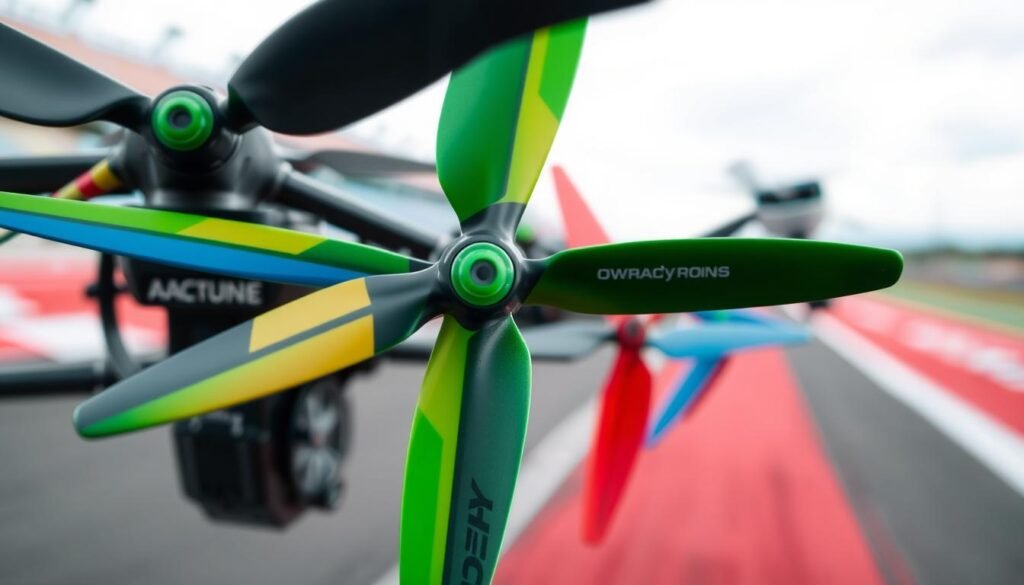
ARRIS, Dalprop, EMAX, Gemfan, and T-MOTOR are popular racing propeller brands. They offer blade sizes from 3 to 7 inches. Prices range from $1.59 to $15.99 per set.
Some sets include 2 pairs, while others offer up to 10 pairs. This variety caters to different drone setups and racing needs.
Popular Drone Racing Propeller Brands
EMAX and Gemfan are top choices for high-quality propellers. EMAX’s cyclone series is known for durability and performance. Gemfan offers ultralight options for freestyle and long-range drones.
These brands have an average rating of 4.2 out of 5 stars. This rating is based on 13 customer reviews.
Compatibility with Major Drone Manufacturers
Ensure your propellers are compatible with your drone model. Major drone makers often have specific propeller recommendations. This ensures the best fit and performance for your racing drone.
| Drone Manufacturer | Compatible Propeller Brands |
|---|---|
| DJI | EMAX, Gemfan, T-MOTOR |
| Parrot | ARRIS, Dalprop |
| Yuneec | EMAX, Gemfan |
| Autel Robotics | ARRIS, T-MOTOR |
| Skydio | Dalprop, EMAX |
Look for features like dynamic balancing and durability when choosing propellers. These factors help maximize your racing drone’s performance. The right propellers can unlock your drone’s full potential on the track.
Choosing the Best Propellers for Your Racing Drone
Picking the right propellers is key for top racing drone performance. Consider material, size, pitch, and compatibility when selecting high-performance propellers. These factors greatly impact your drone’s speed and agility.
Carbon fiber propellers are popular among racers for their durability and light weight. They offer excellent thrust and efficiency for pushing your drone to its limits. Folding propellers provide a compact design, reducing crash damage risk.
Different propeller pitch patterns can greatly affect your drone’s speed and agility. Higher pitch propellers generate more thrust for faster acceleration and top speeds. However, they need more power, which can shorten flight time.
Finding the right balance between pitch and efficiency is crucial. This balance optimizes your racing drone’s performance on the track.
Blade design is crucial when picking the best propeller blade designs for racing drones. Blade shape and count affect thrust, efficiency, and overall performance. Tri-blade propellers balance thrust and efficiency well.
Quad-blade propellers generate more thrust but may be less efficient. Ensure your chosen propellers match your drone’s motors and frame.
T-Motor, EMAX, and Gemfan offer high-quality propellers for drone racing. Always buy from trusted sellers to avoid fake or poor-quality products. This ensures your drone’s performance and safety aren’t compromised.
Maintenance and Care for Racing Drone Propellers
Proper care ensures longevity of your drone racing equipment. Regular cleaning and timely repairs boost performance. This applies especially to your racing drones accessories and drone props.
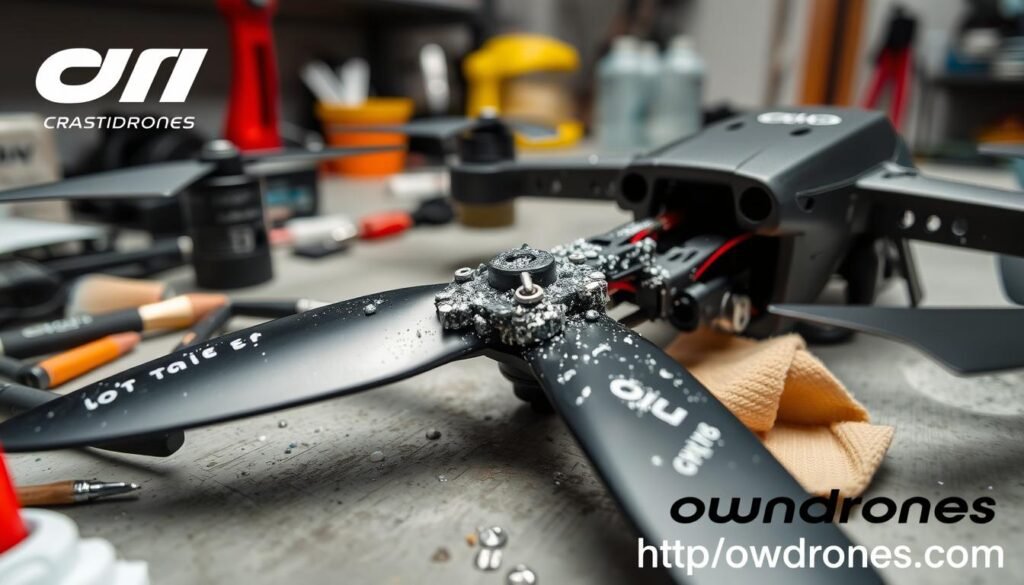
Cleaning and Storage
Clean propellers after each flight to remove dirt and debris. Use a soft brush or cloth for gentle cleaning. Store your drone in a protective case away from sunlight.
High-quality carbon fiber propellers can last 50 to 100 flight hours. This depends on maintenance and storage practices.
Balancing and Tuning
Balancing propellers improves flight stability and reduces vibrations. Inspect for damage regularly. Use a propeller balancer for correct balance.
Tighten screws and nuts properly. This prevents vibrations and extends propeller lifespan.
| Maintenance Task | Frequency |
|---|---|
| Cleaning propellers | After each flight |
| Balancing propellers | Every 10-20 flights |
| Tightening screws and nuts | Before each flight |
Replacing Damaged Propellers
Replace damaged propellers promptly for safety and performance. Check for cracks, chips, or bends regularly. Replace immediately if needed.
Keep spare propellers on hand. This minimizes downtime and ensures continuous flying.
Always prioritize safety when maintaining and caring for your racing drone propellers. A well-maintained set of propellers can make all the difference in your racing performance and enjoyment of the sport.
Conclusion
FPV drone racing success hinges on the right propellers. They come in various types, materials, and designs. Carbon fiber, folding, and high-performance props are popular among competitive racers.
Propeller pitch patterns and blade design impact racing drone performance. They influence thrust, efficiency, and handling. Lightweight materials like carbon fiber allow faster acceleration and better maneuverability.
When choosing FPV drone parts, consider compatibility with your quadcopter and flying style. Regular maintenance and care are essential for top performance. Clean, store, and balance your propellers for consistency and longevity.
Replace damaged or worn props for safety and competitiveness. Understanding propeller intricacies helps unleash your racing drone’s potential. Invest in quality accessories to stay ahead in the race.
